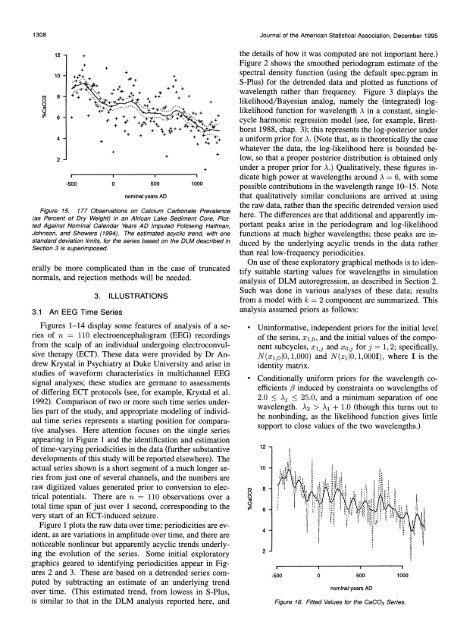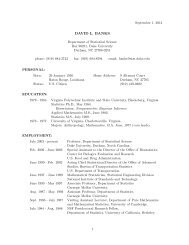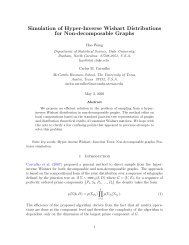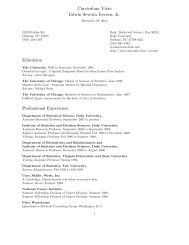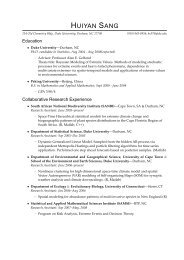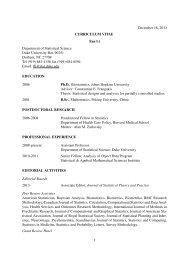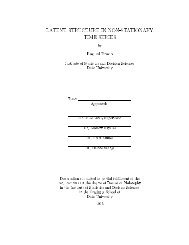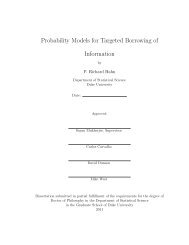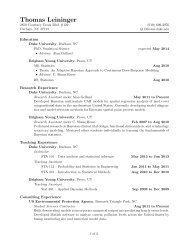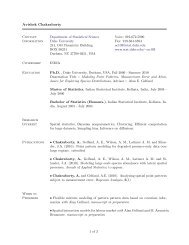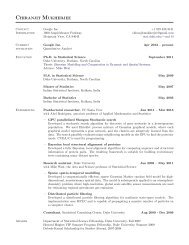Bayesian Inference in Cyclical Component Dynamic Linear Models
Bayesian Inference in Cyclical Component Dynamic Linear Models
Bayesian Inference in Cyclical Component Dynamic Linear Models
Create successful ePaper yourself
Turn your PDF publications into a flip-book with our unique Google optimized e-Paper software.
1308 Journal of the American Statistical Association, December 1995<br />
12 +<br />
10 +++;++<br />
61+a 4~~~X + * + + ++ +<br />
co - 8<br />
+<br />
+<br />
+<br />
+ 4+++ +<br />
+ . 4<br />
+<br />
+ + 4? ++I.<br />
+ + +~~~~~~~~<br />
co ~~~~~~~~~~~~++<br />
++~~~~~~~~~~<br />
2<br />
-500 0 500 1000<br />
nom<strong>in</strong>al years AD<br />
Figure 15. 177 Observations on Calcium Carbonate Prevalence<br />
(as Percent of Dry Weight) <strong>in</strong> an African Lake Sediment Core, Plotted<br />
Aga<strong>in</strong>st Nom<strong>in</strong>al Calendar Years AD Imputed Follow<strong>in</strong>g Halfman,<br />
Johnson, and Showers (1994). The estimated acyclic trend, with one<br />
standard deviation limits, for the series based on the DLM described <strong>in</strong><br />
Section 3 is superimposed.<br />
erally be more complicated than <strong>in</strong> the case of truncated<br />
normals, and rejection methods will be needed.<br />
3.1 An EEG Time Series<br />
3. ILLUSTRATIONS<br />
Figures 1-14 display some features of analysis of a series<br />
of nr= 110 electroencephalogram (EEG) record<strong>in</strong>gs<br />
from the scalp of an <strong>in</strong>dividual undergo<strong>in</strong>g electroconvulsive<br />
therapy (ECT). These data were provided by Dr Andrew<br />
Krystal <strong>in</strong> Psychiatry at Duke University and arise <strong>in</strong><br />
studies of waveform characteristics <strong>in</strong> multichannel EEG<br />
signal analyses; these studies are germane to assessments<br />
of differ<strong>in</strong>g ECT protocols (see, for example, Krystal et al.<br />
1992). Comparison of two or more such time series underlies<br />
part of the study, and appropriate model<strong>in</strong>g of <strong>in</strong>dividual<br />
time series represents a start<strong>in</strong>g position for comparative<br />
analyses. Here attention focuses on the s<strong>in</strong>gle series<br />
appear<strong>in</strong>g <strong>in</strong> Figure 1 and the identification and estimation<br />
of time-vary<strong>in</strong>g periodicities <strong>in</strong> the data (further substantive<br />
developments of this study will be reported elsewhere). The<br />
actual series shown is a short segment of a much longer series<br />
from just one of several channels, and the numbers are<br />
raw digitized values generated prior to conversion to electrical<br />
potentials. There are nr= 110 observations over a<br />
total time span of just over 1 second, correspond<strong>in</strong>g to the<br />
very start of an ECT-<strong>in</strong>duced seizure.<br />
Figure 1 plots the raw data over time; periodicities are evident,<br />
as are variations <strong>in</strong> amplitude over time, and there are<br />
noticeable nonl<strong>in</strong>ear but apparently acyclic trends underly<strong>in</strong>g<br />
the evolution of the series. Some <strong>in</strong>itial exploratory<br />
graphics geared to identify<strong>in</strong>g periodicities appear <strong>in</strong> Figures<br />
2 and 3. These are based on a detrended series computed<br />
by subtract<strong>in</strong>g an estimate of an underly<strong>in</strong>g trend<br />
over time. (This estimated trend, from lowess <strong>in</strong> S-Plus,<br />
is similar to that <strong>in</strong> the DLM analysis reported here, and<br />
the details of how it was computed are not important here.)<br />
Figure 2 shows the smoothed periodogram estimate of the<br />
spectral density function (us<strong>in</strong>g the default spec.pgram <strong>in</strong><br />
S-Plus) for the detrended data and plotted as functions of<br />
wavelength rather than frequency. Figure 3 displays the<br />
likelihood/<strong>Bayesian</strong> analog, namely the (<strong>in</strong>tegrated) loglikelihood<br />
function for wavelength A <strong>in</strong> a constant, s<strong>in</strong>glecycle<br />
harmonic regression model (see, for example, Bretthorst<br />
1988, chap. 3); this represents the log-posterior under<br />
a uniform prior for A. (Note that, as is theoretically the case<br />
whatever the data, the log-likelihood here is bounded below,<br />
so that a proper posterior distribution is obta<strong>in</strong>ed only<br />
under a proper prior for A.) Qualitatively, these figures <strong>in</strong>dicate<br />
high power at wavelengths around A = 6, with some<br />
possible contributions <strong>in</strong> the wavelength range 10-15. Note<br />
that qualitatively similar conclusions are arrived at us<strong>in</strong>g<br />
the raw data, rather than the specific detrended version used<br />
here. The differences are that additional and apparently important<br />
peaks arise <strong>in</strong> the periodogram and log-likelihood<br />
functions at much higher wavelengths; these peaks are <strong>in</strong>duced<br />
by the underly<strong>in</strong>g acyclic trends <strong>in</strong> the data rather<br />
than real low-frequency periodicities.<br />
On use of these exploratory graphical methods is to identify<br />
suitable start<strong>in</strong>g values for wavelengths <strong>in</strong> simulation<br />
analysis of DLM autoregression, as described <strong>in</strong> Section 2.<br />
Such was done <strong>in</strong> various analyses of these data; results<br />
from a model with k = 2 component are summarized. This<br />
analysis assumed priors as follows:<br />
* Un<strong>in</strong>formative, <strong>in</strong>dependent priors for the <strong>in</strong>itial level<br />
of the series, x1,0, and the <strong>in</strong>itial values of the component<br />
subcycles, x1,j and xo,j for j = 1, 2; specifically,<br />
N(xi,o10, 1,000) and N(zi 0,1,000I), where I is the<br />
identity matrix.<br />
* Conditionally uniform priors for the wavelength coefficients<br />
3 <strong>in</strong>duced by constra<strong>in</strong>ts on wavelengths of<br />
2.0 < A. < 25.0, and a m<strong>in</strong>imum separation of one<br />
wavelength. A2 > A1 + 1.0 (though this turns out to<br />
be nonb<strong>in</strong>d<strong>in</strong>g, as the likelihood function gives little<br />
support to close values of the two wavelengths.)<br />
12 -<br />
J<br />
12J<br />
c~~,8 I~<br />
1I I I I<br />
-500 0 500 1000<br />
nom<strong>in</strong>al years AD<br />
Figure 16. Fitted Values for the CaCO3 Series.


